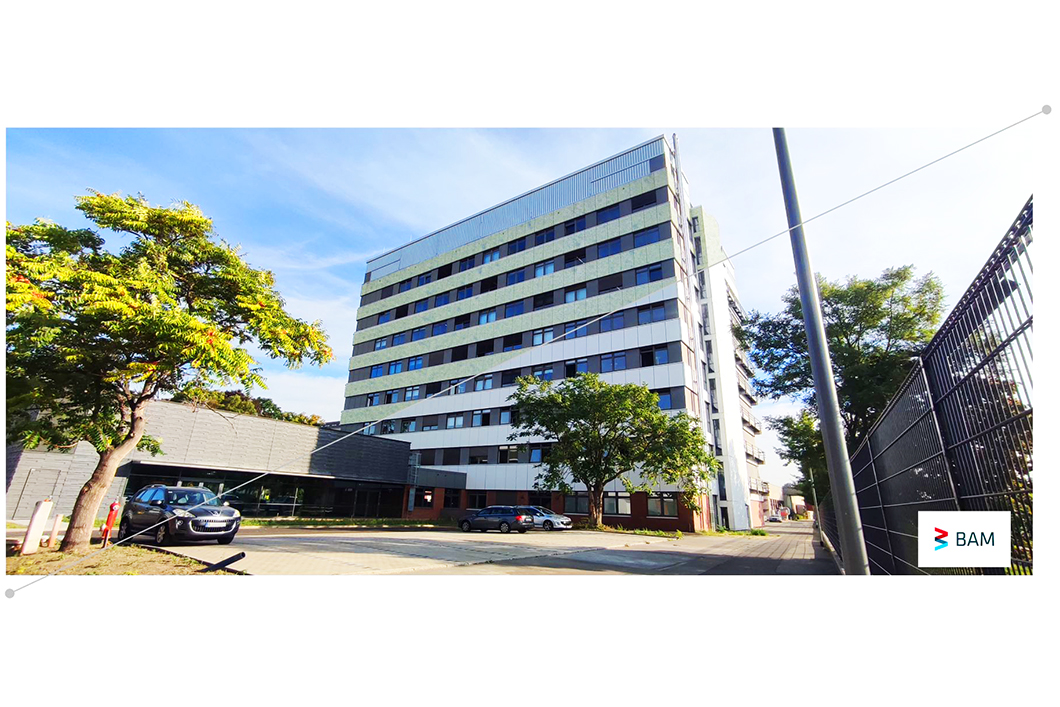
Vision of a facade covered with biofilm
Source: BAM
Project period
01/06/2021 - 31/01/2023
Project type
Collaborative research project
Project status
Closed
Description
The research is focused on the development of new facade elements made of concrete which are covered by a biofilm. The new panels shall not only have an esthetical quality but also mitigate air pollution and provide evaporative cooling.
Location
Bundesanstalt für Materialforschung und -prüfung (BAM)
Unter den Eichen 87
12205 Berlin
Source: BAM
Source: BAM
Source: BAM
Source: BAM
Algae biofilm facades
Inner-city air pollution and the increasing impact of the "heat-island effect" due to climate change have long been identified as key problems in large cities and reduce quality of life and health of residents significantly. According to the European Environment Agency, around 90% of the urban population in the EU is exposed to concentrations of particulate matter, nitrogen oxides, and ground-level ozone which have health-threatening effects. Long-term or transient exposures can cause a range of symptoms from respiratory illnesses to premature death and even lead to premature births. Vertical gardens require high level of maintenance costs and intensive gardening. Therefore, it is important to find a bio-inspired alternative solution which can provide similar or superior values while needs less maintenance and consequently lower maintenance cost.
State of scientific knowledge
Different researchers have tried to find new bio-inspired solutions to mitigate the impact of concrete construction on climate change and global warming. For instance, establishment of moss on facade panels has already been assessed in various projects. However, mosses are not tolerant enough to climatic conditions and currently a research project "Moostex" has the aim to test additional moss species as well as different irrigation systems. Biofilms are easier to maintain and more tolerant of air pollution in comparison with mosses. Algae has been used for biomass production in a building in Hamburg for the first time, but it was based on installing glass panels containing algae and water on the building façade. Direct application of algae on concrete surface is a novel idea and only a limited number of researchers have studied it. Therefore, there are still key questions which need to be answered such as:
- How should initial biofilm be composed and stabilised to ensure long-term stability and visual appearance?
- Which concrete mix design and microstructure as well as which wetting behaviour favoures the attachment and uniform spreading of the microorganisms?
- What application method favoures rapid establishment of the biofilm on the facade?
- How must the demand-controlled irrigation and the supply of trace elements be designed to enable optimal growth and persistence?
- What is the contribution of façade systems to the metabolism of air pollutants especially CO2, NO2?
- What is the contribution of façade elements to the reduction of surface temperature after solar radiation and to the retention of precipitation water?
- How is the aesthetic impression assessed and how can the new elements be integrated architecturally?
This research will provide comprehensive answers to these questions.
Testing and measurements
This interdisciplinary research project is divided into five work packages. The first work package includes the design and manufacture of the test specimens. BAM division Building Materials will determine the chemical composition of the substrate as well as the attachment conditions and the water availability for the microorganisms which will be optimised. To ensure that product development is in align with the industry requirements, BNB which is a precast concrete manufacturer gets involved in the conception phase. BAM department Materials and Environment together with a small startup company named Solaga are responsible to select and characterise targeted microorganisms. The second work package comprises the execution of the laboratory test. As soon as the first substrates with biofilm are available, they are to be artificially weathered under defined conditions. BAM department Materials and Environment and Solaga will determine the species composition and quantify the biomass and the potential for uptake of CO2 and NO2 over time, while BAM department Safety of Structures will analyse the occupation density and the corrosive potential. The core of the third work package is the performance of outdoor weathering experiments, with regard to planned work in the second work package. In addition, systems for irrigation will be tested and the evaporation capacity will be recorded under real climatic conditions. Also, the metabolism of particulate matter over time can only be analysed under real conditions for reasons of representativeness. The core of the fourth work package is the upscaling of the most promising set-up, which is supported by the company BNB. In the fifth work package, aesthetic aspects of concrete panels covered by the algal biofilm will be evaluated in a design workshop conceived by the chair of social and health care buildings and design of the TU Dresden.
Project management
Bundesanstalt für Materialforschung und -prüfung (BAM) Building Materials division
Project partners
Bundesanstalt für Materialforschung und -prüfung (BAM) with
BAM's Building Materials division and
BAM's Materials and Environment department
Solaga UG
BNB-Potsdam GmbH
TU Dresden
Financial support
The project is funded by the Zukunft Bau programme of the Federal Ministry of Housing, Urban Development and Construction.


